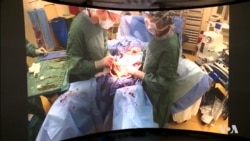For now, virtual reality is still mostly associated with video games. But computer chips that process video images are getting better and better at fooling our minds, and they could soon be able to convince us we are someplace we are not.
Scientists at a University of Maryland computer lab called the Augmentarium, together with physicians from the university’s Shock Trauma Center, are mixing virtual reality with the real world to create something called "augmented reality." The technology could have applications in such fields as military combat, medicine and public safety.
For instance, soldiers wearing special goggles while on the battlefield could be able to see critical data without averting their eyes from the scene. Or, surgeons in an operating room could take a whole new approach to their work.
“Right now," said Dr. Sarah Murthi, a trauma surgeon at the University of Maryland Medical Center in Baltimore, "I put a probe on you and I have to look at the screen over here, and the patient monitors may be up here, and I’m not really looking at the patient. You can imagine, if I were wearing these glasses and I put the probe on the patient, now I can look directly at you. We are still talking, and now I can still look at your heart. So it makes it much more immediate.”
Fusing images from multiple surveillance cameras into a virtual reality could also help security officers more effectively monitor different areas.
“Public safety officials will be able to transport themselves virtually from one part of the campus to another part and respond to emergency situations,” said Amitabh Varshney, a professor of computer science at the University of Maryland's Institute for Advanced Computer Studies.
Researchers admit that virtual reality headsets are still bulky, but they point out that early smartphones were also large, had a short battery life and no touch interfaces.
“Today, as the smartphones have gotten smaller, they are more portable. The whole field of social media engagement has emerged out of the smartphones," Varshney said. "And we believe something similar is going to happen with virtual augmented reality headsets.”
Scientists say that with sufficient funding, this innovative technology could be available in three to five years.








